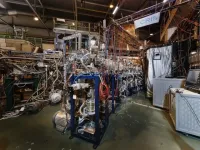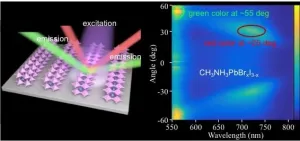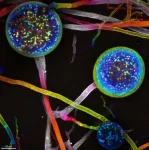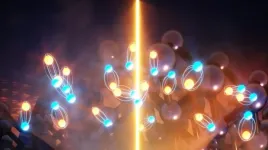(Press-News.org) COLUMBUS, Ohio - Considering the greater good by social distancing during a pandemic turns out to have an attractive personal benefit: A new study has found that staying away from others also reduces an individual person's chances of contracting COVID-19.
Researchers presented study participants with virtual behavior scenarios of various public settings - a grocery store, a crowded beach, a crosswalk - and asked them to place themselves or fictional people in those contexts based on their social distancing preferences.
Four months later, the participants were asked if they had tested positive for SARS-CoV-2 infection or otherwise believed they had been sick with a case of COVID-19.
Statistical analyses showed that the more participants demonstrated a preference for social distancing in the scenarios, the less likely they were to have gotten sick with COVID-19. The study's implication was clear - what was good for society according to public health advice was also good for individuals who wanted to avoid the virus.
"The evidence from our work indicates there is value in socially distancing - not only to reduce the spread of a virus within a community, but because it is actually beneficial for the individual engaging in the social distancing," said Russell Fazio, senior author of the study and a professor of psychology at The Ohio State University.
"There's a selfish notion to it all: 'Hey, it's good for me personally. I'm not just benefiting other people.'"
The research is published today (Feb. 4, 2021) in Proceedings of the National Academy of Sciences.
The researchers did ask participants to report how much they practiced social distancing in real life. But the team added an innovative element: virtual social distancing scenarios in which participants made "in the moment" decisions about how they would react in different situations.
"The virtual behavior measure worked much better as a predictor of illness than the self-report measure, and there are a variety of explanations for that," Fazio said.
For example, some people may over-report their actual self-distancing behavior to provide a good impression to others.
"If I like to view myself as somebody very conscious of the science and supportive of reducing the pandemic, that is also affecting my memory process when I try to engage in this reconstruction and provide a rating that represents what my past is like," Fazio said.
"The virtual behavior measure, which required asking at a moment in time, in a concrete situation, 'What would you do?' did a better job than an abstract summary report of someone's past."
Fazio's lab studies how personal beliefs and attitudes influence behavior. When COVID-19's emergence in the United States led to lockdowns and stay-at-home orders, his team agreed to devote their efforts to trying to understand social distancing behavior.
"The entire lab group came to view the pandemic as a call to action for behavioral scientists because this was ultimately a test of human behavior," Fazio said. "Rarely does a whole society get called upon to change behavior."
The researchers recruited participants from Amazon's Mechanical Turk crowdsourcing marketplace. The sample in this study consisted of 1,885 U.S. citizens representing a range of ages, geographical locations and political ideologies.
In separate surveys conducted in May and June, participants were asked whether they had pre-existing health conditions or jobs that required them to leave home, and the extent to which they were socially distancing - either at the time of the survey or looking back in time if they were responding after economies had begun to open.
The virtual behavior scenarios, initially created for a study of interactions with strangers, were expanded for this new research. Fazio's team told participants the scenarios would be used to assess "people's behavior in common everyday situations, and how this behavior may have changed in light of the current COVID-19/coronavirus pandemic." Researchers instructed participants to view scenes of social situations and indicate how they personally, as individuals, would navigate them.
Ten scenarios were presented. Four situations assessed walking routes participants would take along a street or park path or in a library with people around, and which seat they would choose in a coffee shop. In six interactive scenarios, participants moved a slider to indicate how much distance they would want between themselves and friends, grocery shoppers, a passing stranger or several people standing in line; drew the path they would take crossing a crowded plaza; and placed their towel on a busy beach. Responses were compiled into a composite score for each participant, with a higher score indicating more adherence to social distancing recommendations.
Four months later, the researchers asked the participants if they had been tested for COVID-19 since they had completed the surveys and, if so, whether they tested positive or negative. Those who had not been tested were asked if they believed they had ever had COVID-19.
At the time of the follow-up, 199 participants reported either a positive test result since the initial surveys (85 people) or that they believed they had contracted COVID-19. The researchers measured relationships between the survey variables - pre-existing health condition, working outside the home, self-reported social distancing practices and virtual scenario scores - and the likelihood of contracting the virus, either based on actual positive tests or people's beliefs that they had caught the virus.
Statistical analyses consistently yielded the same results: The more participants exhibited social distancing behavior, the less likely they were to have contracted COVID-19. The strongest evidence that social distancing was protective to individuals was found in the relationship between a low virtual behavior score and higher odds of testing positive for COVID-19.
INFORMATION:
This work was supported by the National Science Foundation. Co-authors include Benjamin Ruisch, formerly an Ohio State postdoctoral researcher now at Leiden University, and graduate students currently in Fazio's lab: Courtney Moore, Javier Granados Samayoa, Shelby Boggs and Jesse Ladanyi.
Contacts:
Russell Fazio, Fazio.11@osu.edu
Benjamin Ruisch, b.c.ruisch@fsw.leidenuniv.nl
Written by Emily Caldwell, Caldwell.151@osu.edu
Scientists like the John A. Moran Eye Center's Paul S. Bernstein, MD, PhD, know a special class of lipids, or fatty acids, found in the retina of the eye and in just a few other parts of the body play an important role in maintaining vision.
But it's been difficult to study whether giving these lipids, called very-long-chain polyunsaturated fatty acids (VLC-PUFAs), to patients as a supplement could prevent blinding eye diseases like age-related macular degeneration, diabetic retinopathy, and some inherited retinal diseases. Made in the body by the ELOVL4 enzyme but rarely consumed as part of a normal diet, VLC-PUFAs weren't commercially available ...
In nuclear physics so-called magic number are such nuclear proton and/or neutron numbers, for which the nucleus is more stable compared to neighboring isotopes on the nuclear chart. Researchers in both experimental and theoretical nuclear physics from University of Jyväskylä, Finland, took part of international research team, which studied the nuclear charge radii of potassium isotopes. Isotopes were studied by using the collinear resonance ionization spectroscopy technique. The results indicated that the potassium isotope with a neutron number of 32 does not conform with criteria of magic neutron number. The results were published in Nature Physics journal on January 2021.
Far from the stable ...
Lead halide perovskites, with high refractive index and excellent optoelectronic property, have been used in both constructing high-quality optical resonators/lasers and fabricating high-efficiency light-emitting devices for advanced displays. Lenticular printing provides an illusion of depth and shows varying images upon view angles, which is considered as a promising approach towards future stereoscopic displays. To realize lenticular-printing-based display, it is required to modulate the outcoupling direction of emission light rather than that of incident light. Ideally, the lenticular-lens-like structures would be integrated into the active layer of light-emitting devices. Therefore, the hybrid perovskite becomes a promising candidate for ...
Researchers at Baylor College of Medicine found that while most individuals responded to respiratory syncytial virus (RSV) natural reinfection with a typical sustained antibody response associated with protection, a few individuals surprisingly responded atypically, not being able to sustain the antibody response, which declined to levels that made the individuals susceptible to RSV reinfection.
The researchers highlight in their study, published in the journal Vaccine, that their findings point at a subpopulation of people who also may not maintain an antibody response to vaccines and suggest the need to characterize patient-specific responses to respiratory viral infections, such as COVID-19.
"RSV is ...
Anyone who's been to a concert knows that something magical happens between the performers and their instruments. It transforms music from being just "notes on a page" to a satisfying experience.
A University of Washington team wondered if artificial intelligence could recreate that delight using only visual cues -- a silent, top-down video of someone playing the piano. The researchers used machine learning to create a system, called Audeo, that creates audio from silent piano performances. When the group tested the music Audeo created with music-recognition ...
Researchers from the University of Ottawa have discovered that plants may be able to control the genetics of their intimate root symbionts - the organism with which they live in symbiosis - thereby providing a better understanding of their growth.
In addition to having a significant impact on all terrestrial ecosystems, their discovery may lead to improved eco-friendly agricultural applications.
We talked to research lead Nicolas Corradi, Associate Professor in the Department of Biology and Research Chair in Microbial Genomics at the University of Ottawa, ...
LA JOLLA, CA--As the opioid epidemic raged on with an even greater force during COVID-19, the Scripps Research laboratory of chemist Kim Janda, PhD, has been working on new therapeutic interventions that may be able to prevent the bulk of deaths from opioid overdose.
Janda and his team have developed experimental vaccines that have shown in rodents to blunt the deadly effects of fentanyl--which has been driving the boom in opioid deaths--as well as its even more fatal cousin, carfentanil, a growing source of overdoses and a chemical terrorist threat.
"Synthetic opioids are not only extremely deadly, but also addictive and easy to manufacture, making them a formidable public health threat, especially when the coronavirus crisis is negatively impacting mental health," says Janda, the Ely ...
A team of researchers led by Columbia University has developed a unique platform to program a layered crystal, producing imaging capabilities beyond common limits on demand.
The discovery is an important step toward control of nanolight, which is light that can access the smallest length scales imaginable. The work also provides insights for the field of optical quantum information processing, which aims to solve difficult problems in computing and communications.
"We were able to use ultrafast nano-scale microscopy to discover a new way to control our crystals with light, turning elusive photonic properties on and off at will," said Aaron Sternbach, postdoctoral researcher ...
Army scientists evaluated three nonhuman primate species as potential models of SARS-CoV-2 airborne infection, according to results published online this week in PLOS ONE. Their work demonstrates that any of these species may be useful for testing vaccines and therapies in response to the COVID-19 pandemic, which has resulted in over 104 million cases and more than 2 million deaths worldwide in the past year.
Given the global impact of COVID-19, experts are working rapidly to develop medical countermeasures, and testing in animal models is critically important to evaluate the efficacy of these products. Recent studies suggest that aerosol ...
Philadelphia, February 4, 2021 - Researchers have leveraged the latest advances in RNA technology and machine learning methods to develop a gene panel test that allows for highly accurate diagnosis of the most common types of liposarcoma. It quickly and reliably distinguishes benign lipomas from liposarcomas and can be performed in laboratories at a lower cost than current "gold standard" tests. The new assay is described in The Journal of Molecular Diagnosis, published by Elsevier.
"Liposarcomas are a type of malignant cancer that is difficult to diagnose because, even under a microscope, it is hard to differentiate liposarcomas from benign tumors or other types ...




